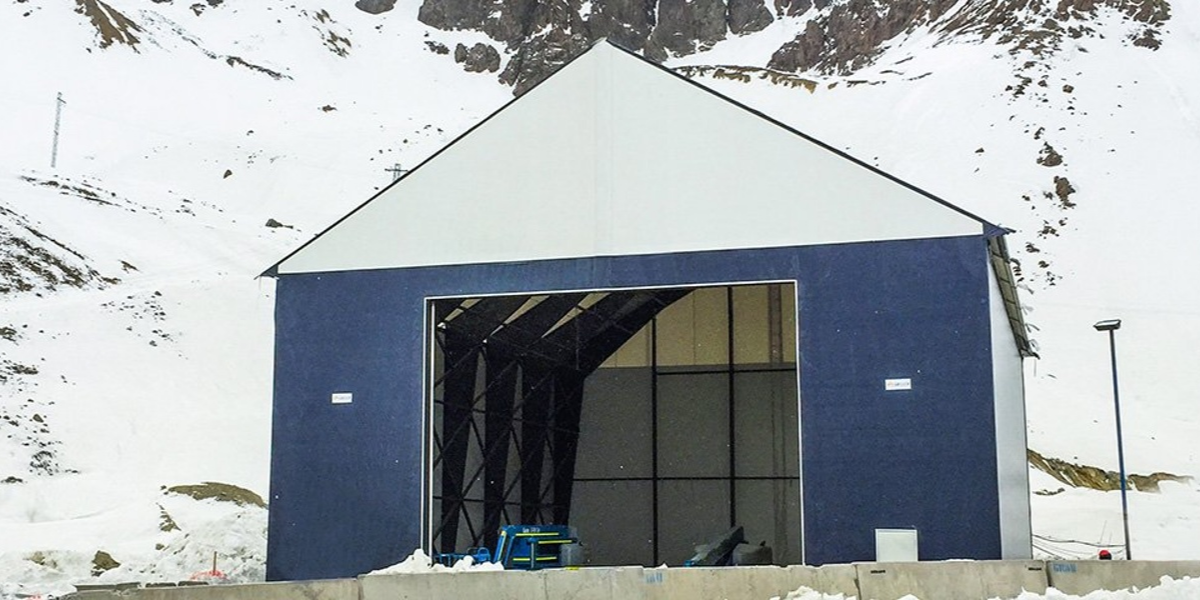Fabric versus Frigid: our track Record worldwide

Extreme cold rarely grabs headlines, but it is a persistent problem in many parts of the world. Buildings are often constructed to provide protection from cold weather and snow.
How do fabric buildings withstand cold? Many of the earliest membrane buildings were constructed in Canada and northern Europe. With this experience in far northern climates, fabric buildings using cold climate design strategies are practical and long-lasting in cold, windy and snowy areas.
Fabric Quality Testing
In addition to practical experience, structural fabric is subjected to rigorous laboratory testing. Independent testing has shown Legacy’s exclusive ExxoTec™ coated PVC fabric to be stronger than competitive fabrics in both initial strength and strength-after-weathering tests.
What does this mean in cases of cold weather? Simply put, ExxoTec™ will not tear, crack, stretch, warp, discolor or otherwise show damage when exposed to cold weather. Read more about the benefits of ExxoTec™ when exposed to different weather conditions.
In addition to the strength of the fabric, all Legacy buildings are constructed with a rigid steel frame, designed to meet code requirements. Buildings in all locations, including regions with mountains, coasts and lake effect winds, are engineered for safety and longevity.
Cold Climate Building Techniques
Fabric building installation relies on stretching the fabric to the proper tension. This ensures the cladding will be at its optimal strength. Professional crews erect buildings worldwide, in all weather conditions.
Experienced, in-house fabric building installation crews provide additional value in cold climates. Crews, along with a headquarters team, calculate the ability to safely install the building based on temperature and other factors on the jobsite.
Safety is a priority in fabric building construction. Learn more.
How Do Snow and Wind Impact Structural Fabric?
Cold climates typically mean wind and snow – two more environmental factors that have an impact on building materials. The key to building safely in any condition is to precisely engineer based on local codes.
Before construction begins, make sure your builder has calculated the roof snow load at the site. Roof snow load is an important factor in designing any building that will be used through the winter. Legacy’s buildings are pre-engineered for code compliance and expedited construction.
ExxoTec™ fabric has a smooth surface, which makes the snow slide off quickly. Some manufacturers incorporate reductions in roof snow load based on the characteristics of snow on fabric. Accounting for the snow shed could lead to an underdesigned roof load. Legacy does not account for the “snow shed” to introduce additional slope reductions other than what is prescribed in the building code.
So how does the fabric hold up to heavy snow? The fabric building pictured above is located in the Andes Mountains of Chile and carries a snow load of 246 pounds per square foot. Secondary bracing gives the building strength to accommodate the snow load plus windspeeds of 75 miles per hour.
In addition to snow and wind loads, the building is also designed to handle significant seismic loads as is required in Chile. It’s designed for housing and maintaining large mining equipment, so providing a protected area for workers is a primary concern for this facility.
But What About the Interior?
A known advantage of structural fabric is its ability to be climate-responsive. Rather than conducting and magnifying the outside temperature, fabric better maintains a consistent interior temperature.
While the fabric does not have any insulative R-value, unlike steel or concrete it is a non-conductive material that does not radiate outside temperatures to the interior of the building. An uninsulated fabric building will stop wind and let in sunshine, making a significant impact on interior comfort.
For applications requiring a warm interior, batten insulation to R-30 as well as heating and cooling systems are available. A climate-controlled building can be used on the coldest or hottest days.
This casino facility in Canada is insulated and used by the public year-round.
Fabric also enhances the effectiveness of the insulation by providing a superior building envelope. The building is constructed without thousands of screws and overlapping panels, providing a significantly tighter building.
These air leaks are often the most common source of heating and cooling loss in a steel building. By stopping these leaks, fabric buildings will save on energy costs and feel more comfortable than similar steel or wood buildings.
Fabric buildings are designed to make cold weather more comfortable, as proven by lab tests and the test of time. No matter the environment or climate, there’s a fabric building solution available. Contact us to learn more.
Subscribe to our Blog
Recent Posts
- 5 Factors Every Project Owner Should Consider Before Approving Building Materials
- The 20-Year View: How Material Choices Impact Long-Term Operational Costs
- Climate Resilience in Commercial Construction: Why Traditional Methods May Not Be Enough
- Speed and Quality: The Role of Hybrid Building Materials
- Beyond the Bleachers: Designing Visually Striking Sports Facilities
